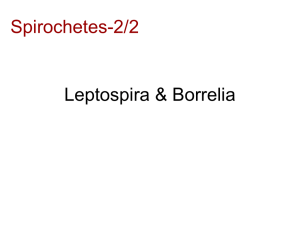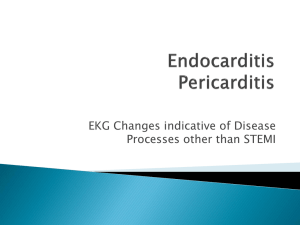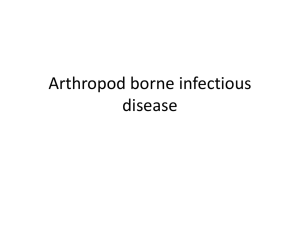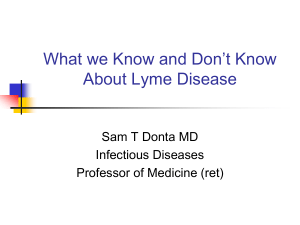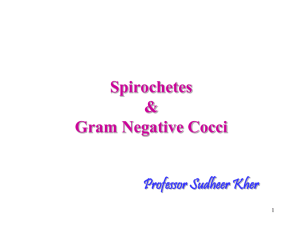Lyme Disease Diagnosis and Treatment—Two
advertisement
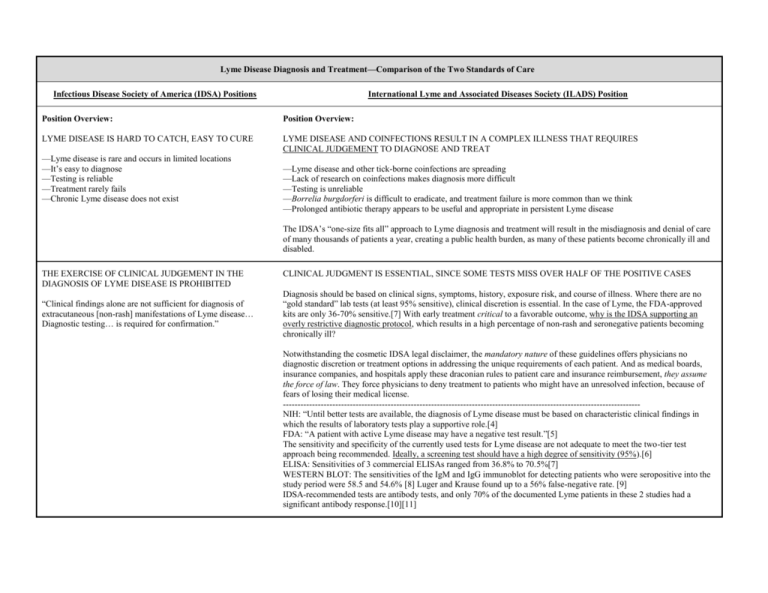
Lyme Disease Diagnosis and Treatment—Comparison of the Two Standards of Care Infectious Disease Society of America (IDSA) Positions International Lyme and Associated Diseases Society (ILADS) Position Position Overview: Position Overview: LYME DISEASE IS HARD TO CATCH, EASY TO CURE LYME DISEASE AND COINFECTIONS RESULT IN A COMPLEX ILLNESS THAT REQUIRES CLINICAL JUDGEMENT TO DIAGNOSE AND TREAT —Lyme disease is rare and occurs in limited locations —It’s easy to diagnose —Testing is reliable —Treatment rarely fails —Chronic Lyme disease does not exist —Lyme disease and other tick-borne coinfections are spreading —Lack of research on coinfections makes diagnosis more difficult —Testing is unreliable —Borrelia burgdorferi is difficult to eradicate, and treatment failure is more common than we think —Prolonged antibiotic therapy appears to be useful and appropriate in persistent Lyme disease The IDSA’s “one-size fits all” approach to Lyme diagnosis and treatment will result in the misdiagnosis and denial of care of many thousands of patients a year, creating a public health burden, as many of these patients become chronically ill and disabled. THE EXERCISE OF CLINICAL JUDGEMENT IN THE DIAGNOSIS OF LYME DISEASE IS PROHIBITED “Clinical findings alone are not sufficient for diagnosis of extracutaneous [non-rash] manifestations of Lyme disease… Diagnostic testing… is required for confirmation.” CLINICAL JUDGMENT IS ESSENTIAL, SINCE SOME TESTS MISS OVER HALF OF THE POSITIVE CASES Diagnosis should be based on clinical signs, symptoms, history, exposure risk, and course of illness. Where there are no “gold standard” lab tests (at least 95% sensitive), clinical discretion is essential. In the case of Lyme, the FDA-approved kits are only 36-70% sensitive.[7] With early treatment critical to a favorable outcome, why is the IDSA supporting an overly restrictive diagnostic protocol, which results in a high percentage of non-rash and seronegative patients becoming chronically ill? Notwithstanding the cosmetic IDSA legal disclaimer, the mandatory nature of these guidelines offers physicians no diagnostic discretion or treatment options in addressing the unique requirements of each patient. And as medical boards, insurance companies, and hospitals apply these draconian rules to patient care and insurance reimbursement, they assume the force of law. They force physicians to deny treatment to patients who might have an unresolved infection, because of fears of losing their medical license. --------------------------------------------------------------------------------------------------------------------------NIH: “Until better tests are available, the diagnosis of Lyme disease must be based on characteristic clinical findings in which the results of laboratory tests play a supportive role.[4] FDA: “A patient with active Lyme disease may have a negative test result.”[5] The sensitivity and specificity of the currently used tests for Lyme disease are not adequate to meet the two-tier test approach being recommended. Ideally, a screening test should have a high degree of sensitivity (95%).[6] ELISA: Sensitivities of 3 commercial ELISAs ranged from 36.8% to 70.5%[7] WESTERN BLOT: The sensitivities of the IgM and IgG immunoblot for detecting patients who were seropositive into the study period were 58.5 and 54.6% [8] Luger and Krause found up to a 56% false-negative rate. [9] IDSA-recommended tests are antibody tests, and only 70% of the documented Lyme patients in these 2 studies had a significant antibody response.[10][11] THE LYME BULLSEYE RASH IS ALL IMPORTANT LYME IS PRIMARILY A NEUROLOGICAL DISEASE, NOT A SKIN DISEASE “The great majority of persons with B. burgdorferi infection present with erythema migrans.” [a bullseye ‘EM’ rash] Only 35-68% Lyme patients present with a bullseye rash.[1][2] But up to 40% develop neurologic involvement of either the peripheral or central nervous system.[3] The IDSA’s overemphasis on the rash and denial of many common neuropsychiatric and neurodegenerative symptoms will result in missed diagnoses and a future epidemic of late stage disease. --------------------------------------------------------------------------------------------------------------------------Many IDSA-cited studies are flawed because of a selection bias for those subjects presenting a rash. The exclusion of neurolyme patients with no rash leads to an artificially high estimate of the incidence of EM rash among those infected with Lyme. What’s more, IDSA guidelines make no reference to the large body of Lyme-related psychiatric literature, and there were no psychiatrists on the guidelines panel. “Extracutaneous [non-rash] manifestations are less commonly seen.” “The more indolent forms of neurologic Lyme disease are quite rare.” TESTING IS RELIABLE AND MANDATORY CLINICAL JUDGMENT IS ESSENTIAL, BECAUSE TESTS MAY MISS OVER HALF OF POSITIVE CASES “Clinical findings alone are not sufficient for diagnosis of extracutaneous [non-rash] manifestations of Lyme disease… Diagnostic testing… is required for confirmation.” Diagnosis should be based on clinical signs, symptoms, history, exposure risk, and course of illness. When laboratory tests are not a “gold standard” (at least 95% sensitive), clinical discretion is essential. In the case of Lyme disease, the FDA-approved kits are 36-70% sensitive.[7] Diagnosis should be based on clinical signs, symptoms, history, exposure risk, and course of illness, with tests playing a supportive role. Since early treatment is essential for a favorable outcome, why is the IDSA supporting an overly restrictive diagnostic protocol that results in a high percentage of non-rash patients becoming chronically ill? --------------------------------------------------------------------------------------------------------------------------NIH: “Until better tests are available, the diagnosis of Lyme disease must be based on characteristic clinical findings in which the results of laboratory tests play a supportive role.[4] FDA: “A patient with active Lyme disease may have a negative test result.”[5] The sensitivity and specificity of the currently used tests for Lyme disease are not adequate to meet the two-tier test approach being recommended. Ideally, a screening test should have a high degree of sensitivity (95%).[6] ELISA: Sensitivities of 3 commercial ELISAs ranged from 36.8% to 70.5%[7] WESTERN BLOT: The sensitivities of the IgM and IgG immunoblot for detecting patients who were seropositive into the study period were 58.5 and 54.6% [8] Luger and Krause found up to a 56% false-negative rate. [9] IDSA-recommended tests are antibody tests, and only 70% of the documented Lyme patients in these 2 studies had a significant antibody response.[10][11] CDC “SURVEILLANCE CRITERIA” SHOULD BE USED FOR DIAGNOSIS USING OVERLY STRICT CDC CRITERIA MISSES UP TO 75% OF POSITIVE CASES “Serum samples should be tested using the 2-tier testing algorithm recommended by the Centers for Disease Control and Prevention.” The CDC explicitly states that this definition is intended for surveillance purposes only, and is "not intended to be used in clinical diagnosis." [12][13] --------------------------------------------------------------------------------------------------------------------------College of American Pathologists (CAP): ELISA assays for Lyme Disease do not have adequate sensitivity to be part of the two-tiered approach of the CDC/ASPHLD[6] Johns Hopkins 2-yr study (2005): The CDC 2-tiered testing procedure misses 75% of positive Lyme cases[14] NY Dept. of Health Letter (1996): CDC’s 2-tiered testing procedure misses 81% of positive Lyme cases.[15] 14-28 DAYS OF ANTIBIOTICS WILL CURE LYME THIS SLOW-GROWING, EVASIVE SPIROCHETE OFTEN REQUIRES LONGER ANTIBIOTIC COURSES “There is no convincing biological evidence for the existence of symptomatic chronic B. burgdorferi infection among patients after receipt of recommended treatment regimens for Lyme disease.” Substantial treatment failures occur using standard protocols. Longer term treatment may be necessary. B. burgdorferi may persist in humans and animals for months or years despite a robust immune response and standard antibiotic treatment, particularly when treatment is delayed and dissemination widespread. Numerous studies have demonstrated persistence of infection despite antibiotic therapy. If the IDSA treatment limits are automatically adopted by the insurance companies, as they have been in the past, thousands of chronically ill Lyme patients will be forced to pay for expensive, possibly life-saving treatments out of pocket, risking the loss of their life savings and their good health. Quality of care will be compromised because the most needy patients will be denied care based on these IDSA “one-size-fits-all” guidelines. ------------------------------------------------------------------------------------------------------------------------------Treatment for 14-21 days results in a 26-50% failure rate. [16] Persistence of B burgdorferi despite antibiotic treatment demonstrated by post-treatment isolation of the bacteria. [17] ANTIBIOTICS DON’T HELP CHRONIC LYME PATIENTS MOST CHRONIC PATIENTS IMPROVE WITH TREATMENT “Antibiotic therapy has not proven to be useful and is not recommended for patients with chronic (≥6 months) subjective symptoms after recommended treatment regimens for Lyme disease.” Both clinical and study evidence show that long-term antibiotics can significantly improve the quality of life for patients with chronic Lyme disease. The potential harm in letting a persistent Lyme infection go untreated far outweighs the potential side-effects of long-term antibiotic use. If long-term oral antibiotic therapy is considered safe enough for acne patients, its use is certainly justified for chronic Lyme patients. Intravenous therapy is justified for serious, refractory cases or those with clear central nervous system involvement. Risks are minimized by skilled clinicians who take appropriate precautions. ------------------------------------------------------------------------------------------------------------------------------Two NIH-funded double-blind studies support retreatment of those failing short-term approaches. Recently completed trial (not yet published) at Columbia University showed the efficacy of at least 10 weeks of IV treatment.[18] Krupp showed efficacy of retreatment in terms of fatigue.[19] Five uncontrolled studies support longer treatment approaches.[20-24] “In many patients, posttreatment symptoms appear to be more related to the aches and pains of daily living rather than to either Lyme disease or a tickborne coinfection.” PREGNANT WOMEN SHOULDN’T WORRY ABOUT HAVING LYME DISEASE “There is little evidence that a congenital Lyme disease syndrome occurs.” PREGNANT WOMEN SHOULD BE FULLY INFORMED OF THE RISKS OF TICK-BORNE DISEASES Lyme disease, as well as other tick-borne infections, can be transmitted from an infected mother to fetus through the placenta during pregnancy, possibly resulting in complications or stillbirth.[25-26] ------------------------------------------------------------------------------------------------------------------------------“46 cases of adverse outcomes …of gestational Lyme borreliosis were found, including miscarriage, stillbirth, perinatal death, congenital anomalies, systemic illness, early-onset fulminant or mild sepsis and later-onset chronic progressive infection.”[27] Transmission to the fetus demonstrated in murine model.[28] B burgdorferi DNA has been detected in human breast milk.[29] THERE IS NO LYME IN THE SOUTH THERE ARE NUMEROUS DOCUMENTED CASES OF INDIGENOUS LYME IN THE SOUTH “The panel is unaware of a proven case of B. burgdorferi infection acquired indigenously in any state south of Maryland Indigenous Lyme has been documented by clinicians, military bases, and health departments across the southern states. With early treatment being essential to favorable outcomes, it behooves southern physicians and epidemiologists to remain or Virginia.” open-minded about Lyme disease as a differential diagnosis, especially with the ease in which it can be acquired while traveling out of state. If front-line physicians are told Lyme is rare, based on opinions only, it could result in missed diagnoses and a future epidemic of late stage disease. ------------------------------------------------------------------------------------------------------------------------------From 1984–1989, 104 indigenous cases of Lyme disease were reported in North Carolina. [30-31] From 1997-2000, there were 44 cases of Lyme disease on Navy and Marine bases in North Carolina. [32] The U.S. Army conducts regular Lyme Disease Risk Assessments (LDRAs) at military installations and has determined that these southern states have been designated as HIGH RISK for Lyme (AR, CA); MODERATE RISK (NC, SC, CA, FL, KY) and SOME RISK (FL, GA, LA, MO, OK). [33] In 2005, the CDC reported 313 cases of Lyme in the states south of Virginia.[34] NIH, National Institute of Health; CDC, Centers for Disease Control & Prevention; FDA, Food & Drug Administration; ELISA, enzyme-linked immunosorbent assay References 1. Stricker RB et al: Lyme disease without erythema migrans: cause for concern?; Am J Med 2003; 115:72 2. Centers for Disease Control and Prevention (CDC). Lyme Disease – USA, 2001–2002. Morb. Mortal. Wkly Rep. 53(17), 365–369 (2004). 3. Fallon, BA, Nields, JA. Lyme disease: a neuropsychiatric illness. Am Journal of Psychiatry 1994 151: 1571-1583 4. National Institute of Allergies and Infectious Diseases (National Institute of Health). How Lyme Disease Is Diagnosed.1999. Available from: http://www.niaid.nih.gov/dmid/lyme/diagnosis.htm 5. Food & Drug Administration. Lyme disease test kits: potential for misdiagnosis. FDA Medical Bulletin, 1999, Summer, Final Issue. http://www.fda.gov/medbull/summer99/Lyme.html 6. Bakken LL, SM Callister, PJ Wand, and RF Schell. Interlaboratory comparison of test results for detection of Lyme disease by 516 participants in the Wisconsin State Laboratory of Hygiene/College of American Pathologists Proficiency Testing Program. J Clin Microbiol. 1997; 35(3): 537-43. 7. Marangoni, et al. Comparative evaluation of three different ELISA methods for the diagnosis of early culture-confirmed Lyme disease in Italy. J Med Microbiol 2005 54: 361-367 9. Engstrom, S.M., E. Shoop, and R.C. Johnson, Immunoblot interpretation criteria for serodiagnosis of early Lyme disease. J Clin Microbiol, 1995. 33(2): p. 419-27. 8. Luger, SW, and E Krauss. "Serologic tests for Lyme disease: interlaboratory variability." Archives of Internal Medicine 15 (1990): 761-763. 10. Aguero-Rosenfeld, ME, Nowakowski, J, McKenna, DF, Carbonaro, CA, and GP Wormser. "Serodiagnosis in early Lyme disease." Journal of Clinical Microbiology 31 (1993): 3090-3095. 11. Aguero-Rosenfeld, ME, Nowakowski, J, McKenna, DF, Carbonaro, CA, and GP Wormser. "Evolution of the serologic response to Borrelia burgdorferi in treated patients with cultureconfirmed erythema migrans." Journal of Clinical Microbiology 34 (1996): 1-9. 12. Lyme Disease (Borrelia burgdorferi): 1996 Case Definition. CDC Case Definitions for Infectious Conditions under Public Health Surveillance. 13. CDC Testimony before the Connecticut Department of Health and Attorney General's Office. CDC's Lyme Prevention and Control Activities. http://www.hhs.gov/asl/testify/t040129.html 14. Coulter, Peggy, Lema, Clara, Flayhart, Diane, Linhardt, Amy S., Aucott, John N., Auwaerter, Paul G., Dumler, J. Stephen, Two-Year Evaluation of Borrelia burgdorferi Culture and Supplemental Tests for Definitive Diagnosis of Lyme Disease, J. Clin. Microbiol. 2005 43: 5080-5084 15. Letter from B. DeBuono of NY Dept. of Health to C. Fritz of CDC. April 15, 1996. 16. Wahlberg P, H Granlund, D Nyman, J Panelius, and I Seppala. Treatment of late Lyme borreliosis. J Infect. 1994; 29(3): 255-61. 17. Oksi J, M Marjamaki, J Nikoskelainen, and M Viljanen. Borrelia burgdorferi detected by culture and PCR in clinical relapse of disseminated Lyme borreliosis. Ann Med. 1999; 31(3): 225-32. 18. Fallon BA. Laboratory findings in chronic Lyme disease and results of the controlled treatment study. Lyme & Other Tick-Borne Diseases:Technology Leading the Way Conference; 2004 October 22, 2004; Rye Town, NY. 19. Krupp LB, LG Hyman, R Grimson, PK Coyle, P Melville, S Ahnn, R Dattwyler, and B Chandler. Study and treatment of post Lyme disease (STOP-LD): a randomized double masked clinical trial. Neurology. 2003; 60(12): 1923-30. 20. Donta ST (2003). "Macrolide therapy of chronic Lyme Disease". Med Sci Monit 9 (11): PI136-42. PMID 14586290. 21. Donta ST (1997). "Tetracycline therapy for chronic Lyme disease". Clin Infect Dis 25: Suppl 1:S52-6. PMID 9233665. 22. Wahlberg P, Granlund H, Nyman D, Panelius J, Seppala I (1994). "Treatment of late Lyme borreliosis". J Infect 29 (3): 255-61. PMID 7884218. 23. Oksi J, Nikoskelainen J, Viljanen MK (1998). "Comparison of oral cefixime and intravenous ceftriaxone followed by oral amoxicillin in disseminated Lyme borreliosis". Eur J Clin Microbiol Infect Dis 17 (10): 715-9. PMID 9865985. 24. Fallon BA, Tager F, Fein L, Liegner K, Keilp J, Weiss N, Liebowitz M (1999). "Repeated antibiotic treatment in chronic Lyme disease". J Spirochet Tick-Borne Dis 6 (3): 94-102. 25. MacDonald AB (1989). "Gestational Lyme borreliosis. Implications for the fetus". Rheum Dis Clin North Am 15 (4): 657-77. 26. Schlesinger PA, Duray PH, Burke BA, Steere AC, Stillman MT (1985). "Maternal-fetal transmission of the Lyme disease spirochete, Borrelia burgdorferi". Ann Intern Med 103 (1): 67-8. 27. Gardner T. Lyme disease. In: Remington JS and Klein JO, editor(s). Infectious diseases of the fetus and newborn infant. Philadelphia: Saunders; 1995. p. 447-528. 28. Altaie SS, S Mookherjee, E Assian, F Al-taie, SM Nakeeb, and SY Siddiqui. Abstract # I-17 Transmission of Borrelia burgdorferi from experimentally infected mating pairs to offspring in a murine model. FDA Science Forum; 1996 1996. 29. Schmidt BL, E Aberer, C Stockenhuber, H Klade, F Breier, and A Luger. Detection of Borrelia burgdorferi DNA by polymerase chain reaction in the urine and breast milk of patients with Lyme borreliosis. Diagn Microbiol Infect Dis. 1995; 21(3): 121-8. 30. Levine JF, et al. Indigenous cases of Lyme disease diagnosed in North Carolina. South Med J. 1991 Jan;84(1):27-31. 31. Pegram PS Jr et al. Lyme disease in North Carolina. South Med J. 1983 Jun;76(6):740-2. Links 32. McGinnis J et al. Lyme disease reporting for Navy and Marine Corps (1997-2000). Mil Med. 2003 Dec;168(12):1011-4. Links 33. U.S. Army Lyme Disease Assessment Reports 1983-1996 http://members.utech.net/users/10766/lyme.htm 34. CDC. Summary of notifiable diseases, United States, 2005. MMWR 2005;53(53)

